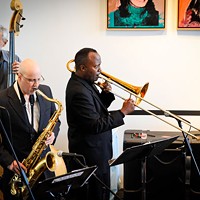It was on the first Friday in July 2010 that Ziad Jazz Quartet member Ron Brendle got empirical support for a long-standing thesis he'd held. That's the evening the crowd for the newly-minted Jazz at the Bechtler monthly series went viral, leaping from around 40 people to nearly 10 times that in just its third show.
"The number of people who attend the event confirms what I've always known," says Brendle, one of the most versatile and musical contrabass players in the city. "There are a lot of people in Charlotte who want to hear live, creative music."
There's even more evidence of that this year. Now in the early stages of its fourth season, Jazz at the Bechtler offers two nightly shows (6 and 8:15 p.m.) on the first Friday of each month. Last season, the event was regularly turning away 100 to 150 jazz fans a night, according to organizers.
It's easy to see the draw. The band — Ziad Rabie on reeds, bassist Brendle, pianist Noel Friedline and drummers Rick Dior, Al Sergel or Brian Sullivan — is top-notch, whether improvising or building swinging grooves. The audience is hip enough to match jazz wits with the players, too, their applause egging on every worthy solo. If you squint, it's almost like a little slice of New York City's 52nd Street, the Mecca for post-World War II jazz.
It's not, of course, as Jazz at the Bechtler takes place in the expansive atrium of the downtown modern art museum. The setting and music are meant to work in concert, and Ziad and museum vice president Christopher Lawing get together before each season to work out overlapping arts and music themes. A prime example follows vibraphonist John Metzger's Sept. 6 gig, when on Oct. 4, the program downstairs — 1968: The Year in Jazz — coincides with the exhibit upstairs, Modernism in Changing Times: Works from 1968.
Most of the shows rely on the explosion of art and music from the post-WWII era, when painters, sculptors, photographers and musicians were radically reorganizing perspective. What Jackson Pollock and Willem de Kooning were doing for painting, Charlie Parker and Dizzy Gillespie did to jazz with be-bop, Miles Davis continued to do with modal jazz, and John Coltrane then did with his quartet's explorations.
Alto saxophonist Ornette Coleman was among the next generation to take that aesthetic even further, and his 1960 album, Free Jazz: A Collective Improvisation, featured a Pollock painting on the cover. "In many ways, the two art forms were integrated as sources of inspiration for the other," Rabie says, "specifically and generally."
The Bechtler jazz programs tend toward familiar names — tributes to Dexter Gordon (Nov. 1), Stan Getz (March 4) and Charles Mingus (June 6) — and seasonal fare like Holiday Jazz (Dec. 6) and Jazz for Lovers (Feb. 7), but the Ziad Jazz Quartet has the improv chops to put their own stamp on them. As Rabie suggests, their audience demands it.
"We did Ornette Coleman, Eric Dolphy, Charles Mingus and late-era Trane stuff" for the November 2012 gig, Existentialism in Jazz, Rabie remembers. "I admit I was nervous about how it would go over. But we were all floored by the audience's knowledge and appreciation — we took it pretty far out, and they were right there with us."

